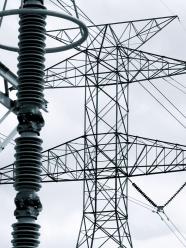|
|
||||

| We are all aware that the nation’s energy infrastructure is aging and desperately in need of new investment. In transmission, the need is particularly critical. The American Society of Civil Engineers graded America’s electrical grid and pipeline distribution systems as a D+ in a 2013 report. In New York, analysis done as part of the state’s Energy Highway initiative found that most of the state’s transmission lines are more than 50 years old and many will need to be replaced in the next 10 years. Whether investments in new infrastructure come from investor-owned utilities, private sector developers, or a combination of both, one thing is clear--the country will need many new projects to be completed and the sooner the better. |
|
Part of the reason for this growing need is the difficult and significant commitment to multi-year siting requirements for these projects. As anyone in the power transmission business can tell you, there are many hurdles to overcome as companies take projects from concept to completion. Transmission Developers Inc. (TDI) was created with a clear mission: to link reliable, low cost clean generation with markets that are in need of more power in a manner that respects the unique characteristics of the communities we traverse. It is a simple concept, but not an easy task. If projects aren’t accepted by stakeholders, those projects won’t be built. With that in mind, here are the top five issues we think need to be addressed when trying to build new transmission projects.
1. How will the project be financed?The traditional “cost of service” model is what most people are used to, however, that model creates two significant obstacles opponents quickly debate—sharing of costs among the jurisdictions that the transmission line traverses and passing related costs on to ratepayers. At TDI, we’ve embraced a merchant business model that brings equity to our projects. We assume the risks that come with the development and construction of a project and the added responsibility of finding our own customers. We believe moving risk from the ratepayer to the developer is a key differentiator that makes merchant projects more attractive to all the stakeholders.
2. What technology will be selected?Obviously, every project is different and technology choices are shaped by many different factors, including economics, location, availability of rights of way, soil and water composition. TDI has selected HVDC voltage source converter technology for our projects. We’ve done this for a number of reasons: this technology is at the forefront of the emerging "smart grid" revolution; it has the ability to run long distances with very little power loss; it can be completely buried; it adds to the robustness of the utility grid and the small installation footprint allows for minimally invasive installation. Whatever technology is selected for a project, communicating why it was chosen should be an important part of the message.
3. What is the best route?It is a route that gets to the desired delivery point in the shortest distance with the lowest possible impact on communities, private landowners and the environment. We address these factors in our route selection with a very low impact transmission system – underground with a minimal installation footprint; the use of existing right of ways wherever possible, and a core commitment to address community, environmental and private landowner concerns. There are many different ways to go from point A to point B. Selecting the route that provides the best chance of moving forward is a balancing act that effectively addresses broader stakeholder interests. This may involve rerouting or mitigation that could add costs. But, short-term savings won’t be savings at all if the project is delayed or never completed due to a poorly chosen route.
4. How will the project be installed?A project that is needed and smartly-designed is still worthless if it can’t get built due to local opposition or other factors. At TDI, we’ve made the conscious decision to use HVDC technology because of its compact design (two 6 inch cables), relative ease of installation (small trenches) and the flexibility to address route conditions through engineered solutions including varying depths, bypassing crossings and going underground to avoid sensitive environmental areas with HDDs (horizontal directional drillings).
5. How are you going to engage the community?Thankfully, long gone are the days when projects were just pushed through with little public input or discourse. Engaging the people most affected by a new project early, in an open and honest way, is vital to the success of any new transmission line. In addition, creating a route and project design and instituting a fully integrated stakeholder outreach and community engagement plan is absolutely vital to the success of any project. In this day and age, communication is king.
Gene Martin joined Transmission Developers Inc. as president and chief operating officer (COO) in January of 2014.
Worried about how the grid will weather all these issues and how we secure new grid components such as transmission builds? Consider attending the Energy Biz Securing Power Forum March 3-4 In Washington D.C. Learn more (or register) by clicking here.
| |
